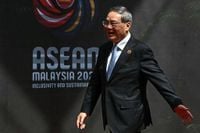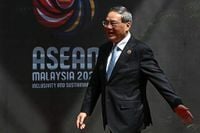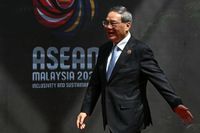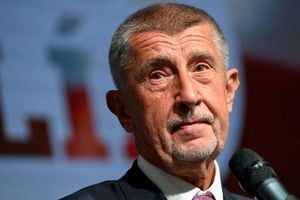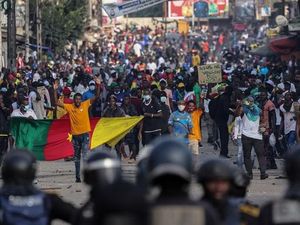Australian Prime Minister Anthony Albanese and Chinese Premier Li Qiang met on October 27, 2025, in Kuala Lumpur, Malaysia, on the sidelines of the 47th Association of Southeast Asian Nations (ASEAN) summit—a meeting that comes at a time of intense global competition over critical minerals and rising geopolitical tensions in the Asia-Pacific. The discussions, described by Albanese as “positive,” tackled both the future of Australia’s minerals industry and recent military incidents that have tested the fragile relationship between the two countries.
The meeting followed the high-profile signing of a $8.5 billion critical minerals deal between Australia and the United States just days earlier. According to the Associated Press, Albanese and U.S. President Donald Trump each agreed to spend $1 billion in the next six months to unlock a pipeline of critical mineral projects—an agreement that signals a major step forward in efforts to diversify global supply chains away from China’s dominance. The deal is focused on Australia’s vast reserves of rare earth elements and other minerals essential to clean energy, high-tech manufacturing, and national security.
“Once again, it was a positive meeting,” Albanese told reporters after his seventh face-to-face with Li Qiang. “This is a relationship that has improved; that is stabilising.” The tone, while optimistic, belied the undercurrents of competition and mutual suspicion that have characterized Australia-China relations in recent years. Since Albanese’s center-left government took office in 2022, China has rolled back a series of trade barriers that once cost Australian exporters up to $13 billion annually, according to the Associated Press. But the path to normalization remains rocky, with each side keenly aware of the strategic stakes involved in the minerals sector.
China, which has recently tightened its own export rules on critical minerals, is watching closely as Australia and the U.S. deepen their partnership. China’s state-run Xinhua news agency reported that Premier Li expressed hope Australia would “provide an open, transparent and non-discriminatory environment for Chinese enterprises to invest and operate in the country.” He also signaled China’s willingness to cooperate with Australia on the green economy, high-tech industries, and digital sectors—areas where both countries have much to gain, but also much to lose if relations sour.
Albanese, for his part, emphasized that Australia shares U.S. concerns over China’s global dominance in critical minerals and control over renewable energy supply chains. Just last year, the Australian government ordered five China-linked companies to divest their shares in Northern Minerals, a rare earth mining firm, citing national interests. Foreign investment rules have also been tightened to prevent Chinese ownership of critical infrastructure—moves that reflect a broader shift toward economic security and strategic autonomy.
Yet, the promise of billions in new investment has not yet reached every corner of Australia’s minerals sector. As reported by the Australian Broadcasting Corporation (ABC), North West Queensland—one of the world’s richest mineral regions—has not seen direct funding from the U.S.-Australia deal, despite holding about 75 percent of Queensland’s base metal and mineral capabilities. The region is home to nearly 30 percent of the world’s vanadium deposits, a mineral crucial for steel alloys and large-scale battery storage, but many mines are years away from operation.
Andrew Napier, head of Multicom Resources and owner of the Saint Elmo vanadium mine, put it bluntly: “That is debilitating for junior miners and startup companies like ours.” He explained that it can take between 13 and 17 years to bring a project from inception to production—a timeline that frustrates both investors and communities eager for economic development. “If they are able to access the finance, they’ll be able to perform their research and their exploration faster,” Napier told ABC. “We’re competing against low-cost countries and our logistics routes—we’re a long way from customers, so transportation is a challenge as well.”
Scott Winter, CEO of Critical Minerals Group, echoed the sentiment, arguing that the U.S. deal is a vote of confidence in Australia’s potential. “Initial investment to help the assets get off the ground is critical… if we could secure offtake from a US customer or the US government, it is paramount,” Winter said. He warned that delays could allow other countries to establish supply chains and dominate the market.
Meanwhile, experts like Professor Rick Valenta of the University of Queensland’s Sustainable Minerals Institute see the deal as a potential catalyst for faster project development. “If you found a new copper deposit tomorrow, the world average time to get into production is over 22 years,” Valenta explained. The hope is that increased investment from the U.S. will help cut down these lengthy timelines, making Australia a more competitive player in the global minerals market. Chris Vernon, CSIRO’s critical minerals lead, told ABC that the deal “will definitely prompt further exploration,” adding, “We’re in a really good position.”
But the minerals race is only one side of the Australia-China equation. The other, more fraught, aspect is security. Albanese used his meeting with Li Qiang to raise concerns about a dangerous encounter between a Chinese Su-35 fighter jet and an Australian P-8 Poseidon surveillance aircraft over the South China Sea on October 19, 2025. According to Australian Defense Minister Richard Marles, the Chinese jet released flares “very close” to the Australian plane—a move described by Canberra as unsafe and unprofessional. Australia lodged an official protest, underscoring the risks of miscalculation in contested airspace.
China, for its part, accused Australia of violating its sovereignty by flying near the Xisha Islands (also known as the Paracels), with military spokesperson Senior Colonel Li Jianjian warning, “The actions of the Australian side seriously violated China’s sovereignty and could easily trigger unexpected maritime or aerial incidents. We sternly warn Australia to immediately cease its infringement and provocation.”
Albanese acknowledged the disagreement but insisted on the importance of frank dialogue. “We have disagreements and friends are able to discuss issues frankly. I did that directly,” he said. “Li heard the message very directly. I’m not here to report in on… what people say when I have meetings.”
Such incidents are not isolated. Earlier this year, Albanese raised similar concerns with Chinese President Xi Jinping after a Chinese naval flotilla conducted live-fire exercises off the Australian coast, forcing commercial aircraft to change course. The exercises were widely seen as a demonstration of China’s growing military reach. Albanese has also previously confronted Li about clashes between Australian and Chinese forces in the South China Sea and Yellow Sea—encounters that Canberra says have endangered its personnel.
Despite these tensions, both leaders appear committed to managing their differences and keeping lines of communication open. The stakes are high: with global demand for critical minerals soaring and the clean energy transition accelerating, Australia’s resources have never been more valuable—or more contested. The challenge now is to turn investment promises into real-world projects, while navigating the complex web of alliances, rivalries, and economic interests that define the Indo-Pacific in 2025.
As the world watches, the outcome of these minerals deals and military standoffs will shape not just Australia’s future, but the balance of power in a rapidly changing region.
